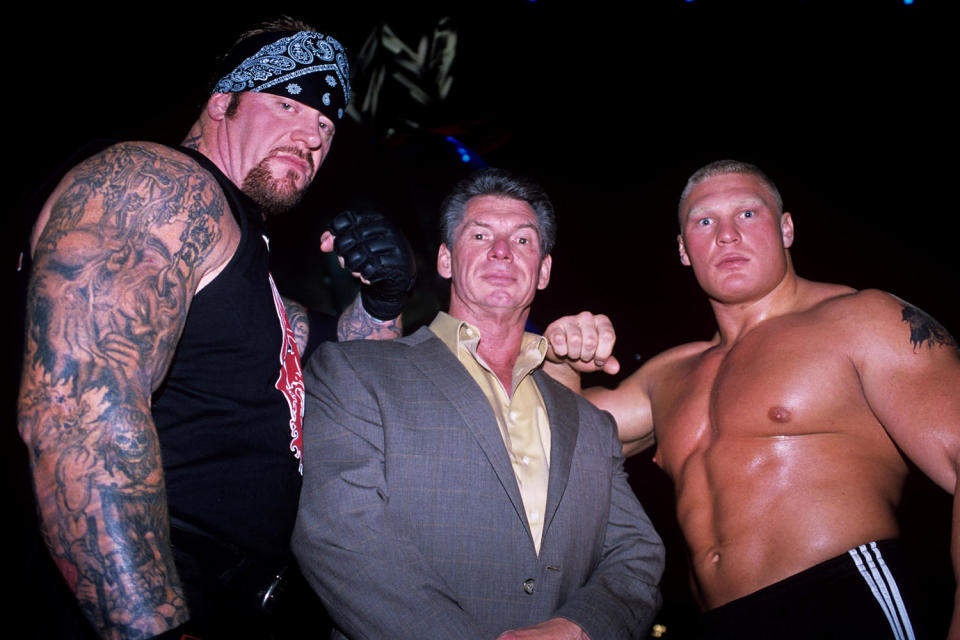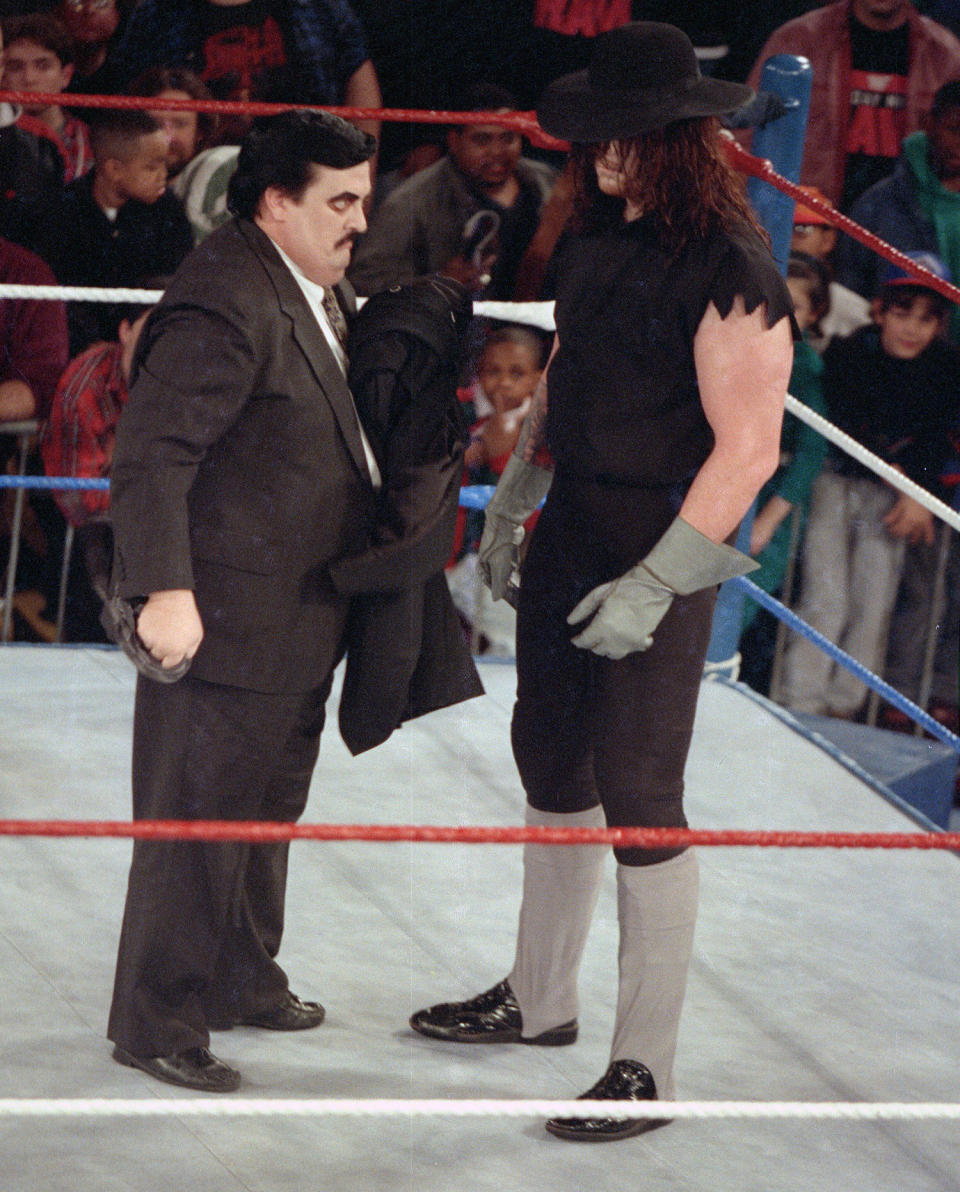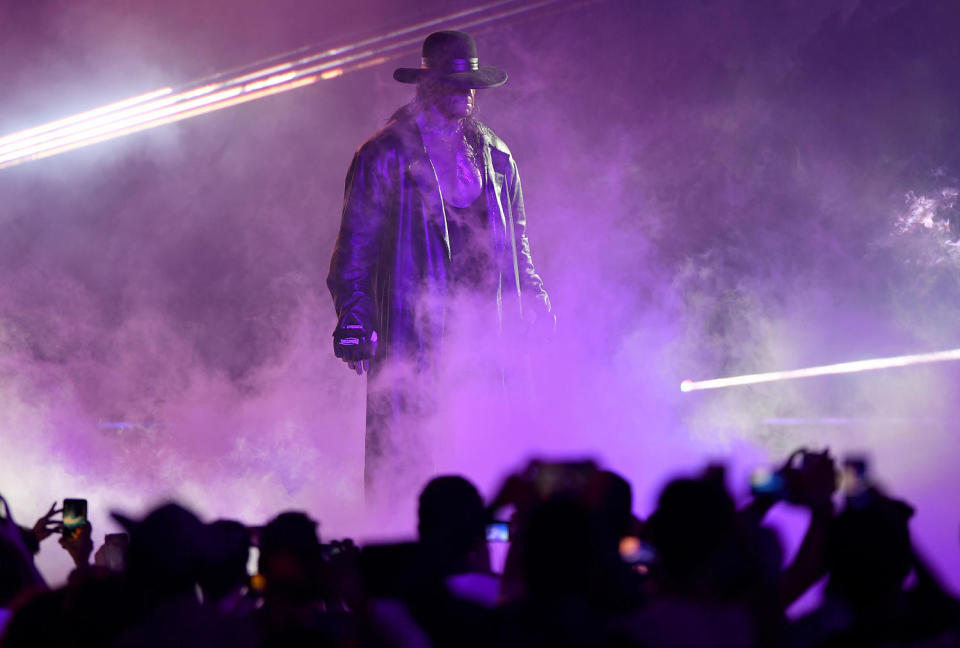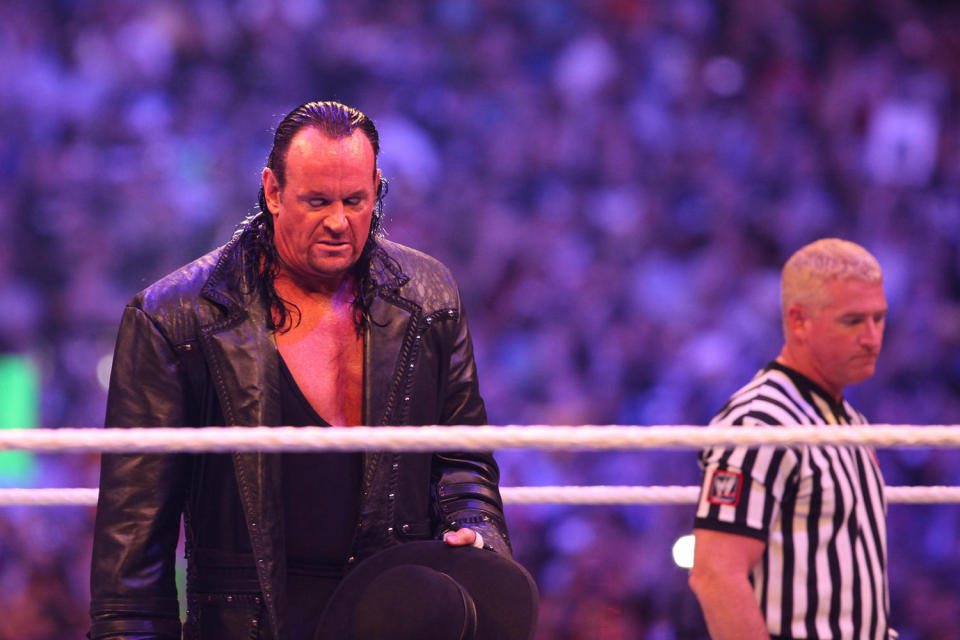After 30 years as the Undertaker, a WWE legend rides off into the sunset
- Oops!Something went wrong.Please try again later.
- Oops!Something went wrong.Please try again later.
In November 1990, the WWE roster was filled with over-the-top personalities — names like the Ultimate Warrior, the Honky Tonk Man and the "Million Dollar Man" Ted DiBiase. No WWE superstar at the time was more over the top than Hulk Hogan, who was still riding a massive wave of popularity thanks to his Hulkamania movement, which preached to fans that they should say their prayers and eat their vitamins.
That month, a new character debuted at one of WWE’s premier events, Survivor Series: the Undertaker. He was also over the top, but he was unlike the other superstars in WWE. An imposing figure at nearly 7 feet tall, he walked with intensity and purpose to the ring, dressed in a black trench coat and wide brim hat, with funereal music as his entrance theme. When he spoke, he didn’t tell anyone to say their prayers and eat their vitamins.
He told them to rest in peace.
“It was very interesting when I debuted. It was quiet. And it wasn’t a quiet, like, ‘I can care less who this is.’ It was a quiet like, ‘What the hell is this?’” the Undertaker, whose real name is Mark Calaway, told TODAY in a recent Zoom interview about the fan reaction to his introduction at Survivor Series.
A year later, the Undertaker, in the role of villain, defeated Hogan at Survivor Series for the WWE Championship — and Calaway could feel the fans supporting him.
“The crowd, even though I was still a heel, or a bad guy, the crowd was 60-40 in my favor. They were cheering for me,” he recalled. “So that’s kind of like, whoa, because that’s — I mean, Hogan is the golden goose, right? I mean, he’s the foundation of the company. That’s when it really started to dawn on me that we were doing something right. And we were on our way.”
Indeed, Calaway was on his way to becoming one of the greatest superstars in WWE history. His legendary career will be honored Friday night when he is inducted into the WWE Hall of Fame in conjunction with WrestleMania weekend. It’s an honor that he describes as both humbling and bittersweet — bittersweet because it will represent the end of his in-ring career.
“In my mind and in my heart, I would still be out there. It’s just, I’m at a point where I physically, I can’t deliver the performance that people expect when they come to see the Undertaker,” Calaway, 57, explained. “And I don’t want to shortchange them, nor do I want to tarnish my legacy and the 30-plus years that I put into this industry creating a legacy and something for people to remember. I don’t want them remembering me hobbling around and not being able to move in a way, in a manner that they’re accustomed to.
“So, for those reasons, I think, you know, it’s my time to say goodbye and ride off into the sunset, if you will.”
Calaway will be inducted into the Hall of Fame by WWE CEO Vince McMahon, whom he credits for being integral to his success.
“He took a chance on me when he didn’t have to, and when he really didn’t necessarily, at the beginning, really believe in me. But he gave me an opportunity, and that just means the world to me. And he’s changed my life forever,” Calaway said.

Creating the Undertaker
That opportunity began before the 1990 Survivor Series, when McMahon showed Calaway — who'd previously worked for WWE rival WCW — the storyboards for his vision for the Undertaker. It was important to Calaway that the Undertaker not be the type of loud, larger-than-life character that was so prevalent in the pro wrestling world at the time. The Undertaker would talk low, and he would talk slow.
“My reasoning behind all that was, is normally if somebody is loud, you know, you kind of give them a look and you’re kind of annoyed and you just turn back around and you mind your own business. But when somebody talks low, you’re a little bit more intrigued, like, what are they saying? So you lean in a little closer, and they grab your attention in a much different way,” he said.
And then there was the content of the messages, which went beyond a wrestler’s usual promise of pinning an opponent 1-2-3.
“I’m talking about taking your soul, throwing you in a casket, letting the worms eat your rotting flesh as I take your soul to hell. I mean, at this time period, nobody’s doing that. Nobody’s talking about things that dark and that heavy. And, you know, no one’s digging graves and throwing dirt,” he said.
“So, you know, it was all of those things that I was concentrating on to make myself different and make myself relevant in a world of superheroes that were really over the top.”
The Undertaker was accompanied for the first several years of his run by a manager, the cleverly named Paul Bearer, who carried a mysterious urn with him. Bearer was the late WWE Hall of Famer William Moody, a travel partner of Calaway’s and a real-life mortician.
Calaway said of the Bearer character, “He’s got the loud, squealy, creepy voice and the high-pitched (delivery), you know, and the ghoulish look. So he was a complete contrast to what I was bringing in. But it was the same message that we just had different ways of approach. It was so good. It was perfect.”

The references to death would go well beyond the Undertaker’s speeches and his manager over the course of his three decades, like his finishing move, the tombstone piledriver, and his nickname, “The Deadman.” He’d compete in Casket matches, Buried Alive matches and Hell in a Cell matches. (The Undertaker would even show off supernatural abilities at times, like commanding lightning to strike down from the ceiling of indoor arenas).
Calaway was on board for any idea, though there was one that gave him some pause: a 1998 Inferno match involving the Undertaker’s on-screen brother, Kane. The goal of the match: to set your opponent on fire.
“I don’t think I ever really lifted a brow at anything until they got to the Inferno match. Well, the Hell in a Cell was, that lifted a brow as well but it was to me, I’m kind of going at it as, OK, well, it’s a souped-up cage match. OK. That’s one thing,” he shared. “But the Inferno match was the first time that I kind of went, ‘Now, wait a minute (laughs). You’re going to light the ring on fire and we got to get out of the ring and not …’
“Yeah. So that was one of probably the first times that, you know — and that was just, I just wanted to know how it was going to be done without, you know, us completely burning our flesh completely off our skin or our arms. But even that worked out well.” (It helped that the Undertaker won the match.)

The Undertaker and ‘The Streak’
Calaway reinvented the Undertaker character several times during his career — at one point, he ditched the darker aspects of the character, wearing a bandana and riding a motorcycle to the ring — but he remained a featured attraction at WWE’s signature event, WrestleMania, where the Undertaker won 21 consecutive matches before famously losing to Brock Lesnar at WrestleMania 30 in 2014. The accomplishment was so unprecedented that it became known simply as “The Streak.”
The Undertaker faced a diverse lineup of opponents during “The Streak” and delivered many memorable matches, but Calaway points to the match with Shawn Michaels at WrestleMania 25 in 2009 as his favorite. With good reason, too: It is widely regarded among fans as one of the greatest WrestleMania matches of all time.
“It’s just one of those magical nights where everything fell into place. … He was clicking on all cylinders. I was clicking on all cylinders. And, you know, something magical happened,” he said.
It’s hard to imagine “The Streak” being duplicated by another WWE superstar in the future. For starters, it’s not often that someone makes 20 WrestleMania appearances, win or lose.
While anything is possible, Calaway said it would be “really, really difficult” to match “The Streak.”
“It’s so hard, and the things that guys are doing today, to stay healthy enough to last that long, you know — I put a lot of stock in modern medicine, but, you know, there’s a lot of factors that are going to play into that.”
He added that it’s also “tough to keep somebody that relevant with so much exposure. I think guys really will burn themselves out before they get that kind of opportunity.”
‘The icing on the cake of my career’
Calaway retired in November 2020, fittingly at Survivor Series. He will now take his place in the WWE Hall of Fame in a ceremony in Dallas on the eve of WrestleMania 38, joining a class of 2022 that also includes Vader, Queen Sharmell and the Steiner Brothers. He said his Hall of Fame speech will be the “finality and the icing on the cake of my career.”
Still, it’s fair to wonder if the native Texan will take part in WrestleMania 38 at AT&T Stadium, home of the Dallas Cowboys, in some fashion. It’s not uncommon for WWE superstars to step back into the ring after retiring — though it’s not being billed as a match, legend “Stone Cold” Steve Austin is scheduled to “confront” Kevin Owens during a WrestleMania 38 segment. And Calaway admits to a moment in January when his wife, former WWE superstar Michelle McCool, competed in the Women’s Royal Rumble match and he got caught up in the excitement of being at a WWE event again.
“I thought I was good with everything and, you know, I get there and in that atmosphere, it’s like, hmm …” he shared.
However, he insisted he has no plans to be part of the action at WrestleMania 38.

“I’m going to leave the nostalgia to Steve and let him have his moment. And hopefully I would’ve — I’m going to recover from my speech that I have to give (laughs) on Friday night and I’ll be able to sit back and enjoy the matches and unwind and spend some time with my family,” he said.
Peacock will stream the WWE Hall of Fame induction ceremony Friday night and WrestleMania 38 on Saturday night and Sunday night. (Peacock is owned by TODAY’s parent company, NBCUniversal.)
This article was originally published on TODAY.com

